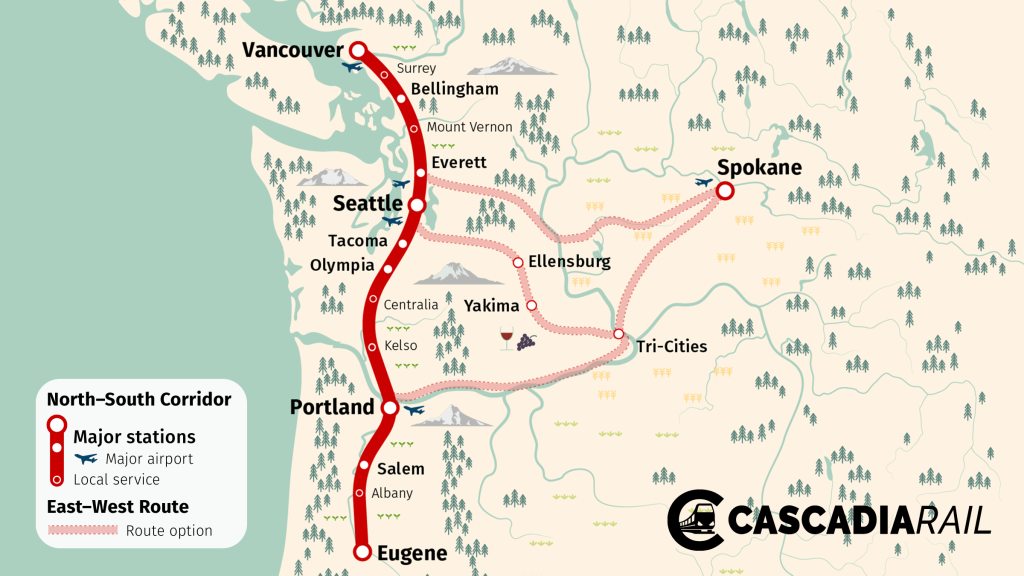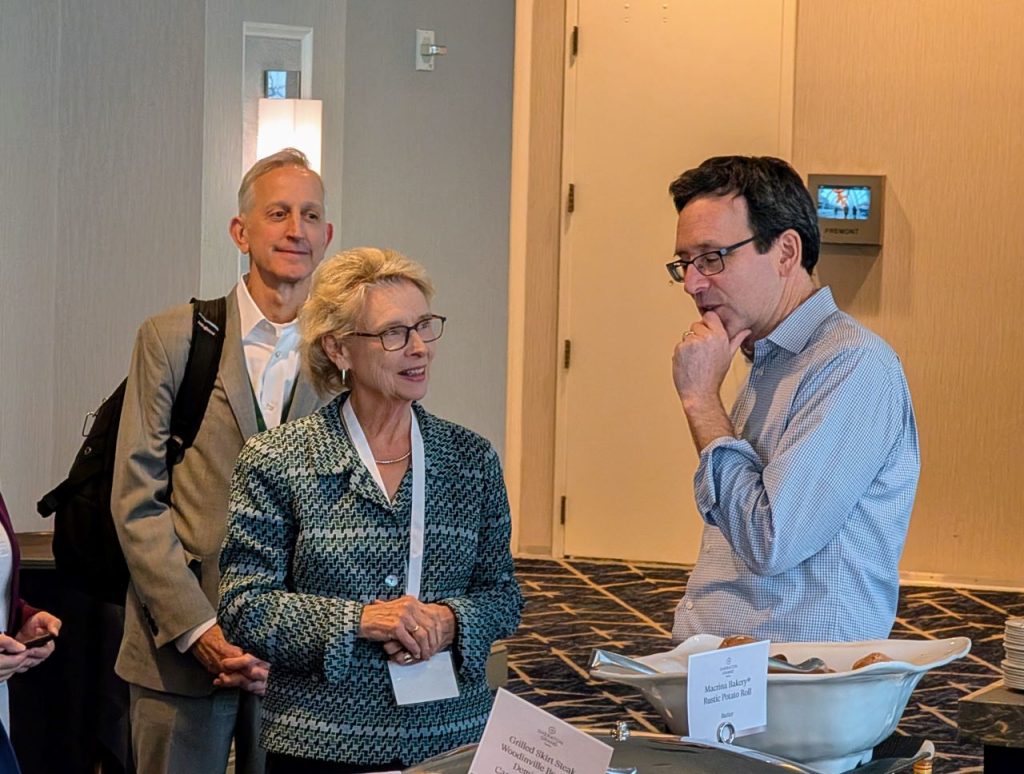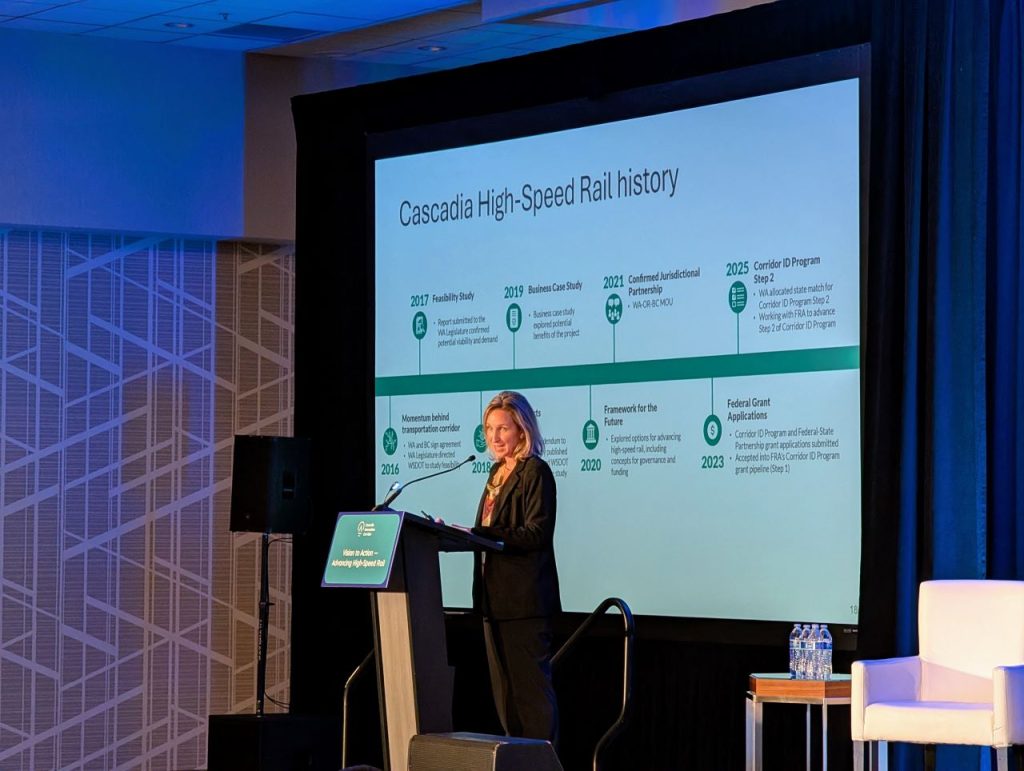
On October 29, leaders from across the Pacific Northwest reaffirmed their commitment to building high-speed rail linking the three largest metropolitan areas of the region at the annual Cascadia Innovation Corridor Conference. Speakers shared ideas for advancing the project and overcoming headwinds created by the Trump administration, which has slashed transit grants and slapped tariffs on trade imports from Canada.
These moves have created obstacles for funding the massive undertaking and finding a path to cross-border collaboration with the Canadian province of British Columbia, which would be needed for the rail line to cross the Canadian border to Vancouver. If that wasn’t enough, large infrastructure projects — from freeway expansions to light rail — are facing massive increases in construction costs, which is likely to greatly impact high-speed rail projects as well.
Conference talks remained high-level and largely sidestepped the issue of how to finance the project. A 2017 feasibility study commissioned by the Washington State Department of Transportation (WSDOT) estimated Cascadia “ultra-high speed rail” would cost between $24 billion and $42 billion — and that was before the era of high construction cost escalation hit.

The two-day conference, held in Downtown Seattle at the Sheraton Grand Hotel, included many top state and local officials and several senior corporate executives in attendance. Several speakers hinted that a public-private partnership was the way to go and would be able to leverage private investment to surmount funding challenges, but nobody unpacked exactly how that would work at this preliminary phase.
Many speakers stressed that the need for a high-speed rail was still acute, given the traffic gridlock common on I-5. Those issues are only likely to snowball as the Cascadia megaregion grows. Defined as stretching from the Portland metropolitan area to British Columbia’s Vancouver metro area and the swath of Western Washington in-between, the Cascadia megaregion is a fast-growing area with a population of nearly 10 million. The region is expected to grow by 3 to 4 million residents by 2050.
The 315 miles (507 kilometers) between Vancouver and Portland could be spanned in as little as two hours with high speed rail, depending on the number of stops and the maximum speeds achieved. Unlike adding another freeway lane on I-5, high-speed rail can scale more efficiently under increased demand, rather than quickly succumbing to congestion issues and getting trapped in a cycle of induced demand.
Pierce County Executive Ryan Mello stressed that high-speed rail could free many of his constituents from soul-crushing long commutes.
“Nearly a quarter of [Pierce County workers are] coming to King County every day to seek a better paying job. Some even have to go as far as Snohomish County for work. These commutes often take 60 minutes, 90 minutes and a little bit of your soul every single time,” Mello said. “Imagine building something today that offers your children a new world of choices about where to go to school, where to work, and where to live, because non-polluting high-speed rail can quickly connect them, not just between Tacoma and Seattle or Seattle and Everett, but all the way to Portland, or all the way to Vancouver, British Columbia.”

Washington Governor Bob Ferguson had a program slot, and former Washington Governor Chris Gregoire had several, acting as the de facto master of ceremonies.
For most of her time since leaving elected office in 2013, Gregoire has led Challenge Seattle, a corporate supergroup that describes itself as an “alliance of 23 organizations who represent some of the Seattle region’s largest employers and most successful innovators.” One of Challenge Seattle’s major focuses has been high-speed rail, which the group has pitched as advancing the economic competitiveness of Cascadia as compared to other mega-regions around the globe. Challenge Seattle was the organizing force behind the conference, with Gregoire also chairing the Cascadia Innovation Corridor steering committee.
Her work with Challenge Seattle has allowed Gregoire to remain highly influential, even more than a decade removed from elected office. Ferguson said Gregoire was a mentor to him and that he valued her counsel, and advised business and governmental leaders to treat her as a conduit for feedback to him.
“Governor Gregoire has me on speed dial, I can assure you,” Ferguson told conference goers. “I talk to her frequently, and so feel free to go via Governor Gregoire as well, if you’re trying to get a message to me.”

Ferguson also credited Gregoire with working with him to pass housing legislation earlier this year. He said housing remained his top priority as governor. Gregoire highlighted that a Cascadia high-speed rail line was also a housing intervention — though she steered away from earlier messaging hyping the idea of building new cities from scratch at intermediate stations between the three high-cost metro areas.
“High-speed rail is a housing strategy,” Gregoire said. “That’s what we’ve thought of it all the way along. It will spark new walkable communities around stations where people can live closer to where they work, where small businesses can thrive, and where families can spend more time together and less time in commuting and traffic. This isn’t just a train. It’s an investment. It’s an investment in our people, in our families, in our neighborhoods that make this region extraordinary. It’s a down payment on a more connected, more vibrant, more affordable Cascadia, one that gives every resident more choices, more opportunity and more time for the things that truly matter.”
Former transportation secretary Ray LaHood (an Illinois Republican appointed by President Obama) stressed the importance of keeping the project moving in hope of capitalizing on a more friendly federal administration down the line.
“If you lay your plans now and you’re all involved and things aren’t quite right, maybe with the national government, we know that’s going to change,” LaHood said. “And if you’re well-positioned, when the next president comes along and has high-speed rail as a priority, boom, you’re first in line.”
LaHood was highly critical of Republicans who spurned rail investment, pointedly calling former Florida Governor Rick Scott (a fellow Republican) an “idiot” for turning down $2.4 billion in federal grants to construct high-speed rail in his state.
The Cascadia project appears to be many years away from the construction grant phase. Chelsea Levy, project manager for Cascadia high-speed rail at the Washington State Department of Transportation (WSDOT), updated attendees on where planning stood. WSDOT secured a $49.7 million federal grant in December 2024 — the waning days of the Biden Administration — to fund the creation a service development plan for Cascadia high-speed rail. WSDOT is leading project development, since the majority of the proposed railroad would be on Washington soil.
“We’re currently in project planning,” Levy said. “We’ll need not only approvals, but additional funding to advance the environmental review processes, both in the U.S. and Canada in the future, and similar to other large megaprojects, large-scale projects, high-speed rail would pursue final design and construction once funding is secured and the environmental review is complete. Specific to high-speed rail, these are the major activities of the service development plan to be completed by 2028.”

Levy laid out four phases for the agency’s service development plan. Those four phases would narrow down corridor options, but not get so far as landing on a final alignment with specific station locations. “A future step after this process, will identify and evaluate potential station locations and further evaluate route options,” Levy noted.
The Trump administration not only dealt a blow to transit funding, but also to the fundamental premise of cross-border collaboration. Rob Fleming, Former British Columbia Minister of Transportation and Infrastructure, flagged this issue during his remarks on October 29.
“So we’re not in a great place to be having this discussion on our side of the border. Canadians are, in fact, busy making contingencies with new trade markets all over the world, and some of this pivot is happening pretty fast. For example, in just nine months, Canadian trade with the United Kingdom is up 75% and our trade with the European Union is up 38% and I don’t know how much of that comes from the Cascadia corridor region. I suspect some, but not overly a lot.”
While Cascadia leaders appear to hope the Trump tariffs are a blip that the next president or a more strident Congress could undo, other obstacles for high-speed rail will outlast Trump. One central tension of the conference surrounded the fact that many of the business leaders lobbying for high-speed rail have also pushed back hard against tax hikes on corporations or the wealth they create for shareholders and executives.
Raising the billions necessary for building high-speed rail will be difficult in such an environment. For his part, Governor Ferguson noted for now he remains tax-averse in a press scrum after his conference appearance — after he also fought tax-the-rich efforts during a chaotic spring session.
“I’m skeptical of additional revenue at this time,” Ferguson told the Washington State Standard.
Correction: The original version had a transcription error in a Chris Gregoire quote, incorrectly replacing commuting with community in this sentence: “It will spark new walkable communities around stations where people can live closer to where they work, where small businesses can thrive, and where families can spend more time together and less time in commuting and traffic.”
Doug Trumm is publisher of The Urbanist. An Urbanist writer since 2015, he dreams of pedestrian streets, bus lanes, and a mass-timber building spree to end our housing crisis. He graduated from the Evans School of Public Policy and Governance at the University of Washington in 2019. He lives in Seattle's Fremont neighborhood and loves to explore the city by foot and by bike.

